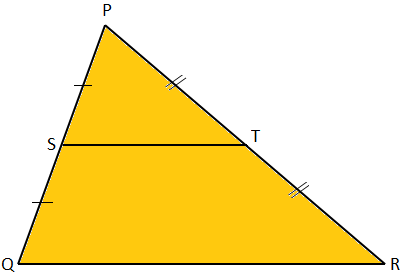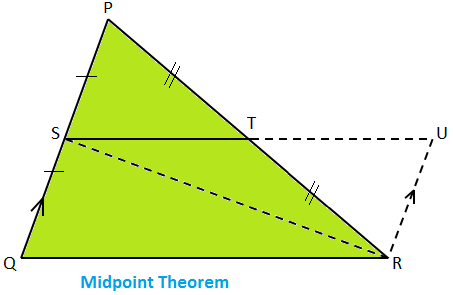Subscribe to our ▶️ YouTube channel 🔴 for the latest videos, updates, and tips.
Midpoint Theorem
Theorem: The line segment joining the midpoints of two sides of a triangle is parallel to the third side and equal to half of it.
Given: A triangle PQR in which S and T are the midpoint of PQ and PR respectively.
To prove: ST ∥ QR and ST = \(\frac{1}{2}\)QR
Construction: Draw RU ∥ QP such that RU meets ST produced at U. Join SR.
Proof:
|
Statement |
Reason |
|
1. In ∆PST and ∆RUT, (i) PT = TR (ii) ∠PTS = ∠RTU (iii) ∠SPT = ∠TRU |
1. (i) T is the midpoint of PR. (ii) Vertically opposite angles. (iii) Alternate angles. |
|
2. Therefore, ∆PST ≅ ∆RUT |
2. By AAS criterion of congruency. |
|
3. Therefore, PS = RU; ST = TU |
3. CPCTC. |
|
4. But PS = QS |
4. S is the midpoint of PQ. |
|
5. Therefore, RU = QS and QS ∥ RU. |
5. From statements 3, 4 and construction. |
|
6. In ∆SQR and ∆RUS, ∠QSR = ∠URS, QS = RU. |
6. From statement 5. |
|
7. SR = SR. |
7. Common side |
|
8. ∆SQR ≅ ∆RUS. |
8. SAS criterion of congruency. |
|
9. QR = SU = 2ST and ∠QRS = ∠RSU |
9. CPCTC and statement 3. |
|
10. ST = \(\frac{1}{2}\)QR and ST ∥ QR |
10. By statement 9. |
From Midpoint Theorem to HOME PAGE
Didn't find what you were looking for? Or want to know more information about Math Only Math. Use this Google Search to find what you need.




New! Comments
Have your say about what you just read! Leave me a comment in the box below. Ask a Question or Answer a Question.